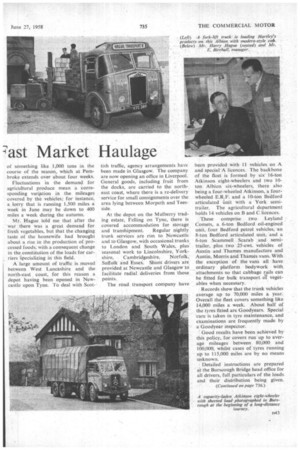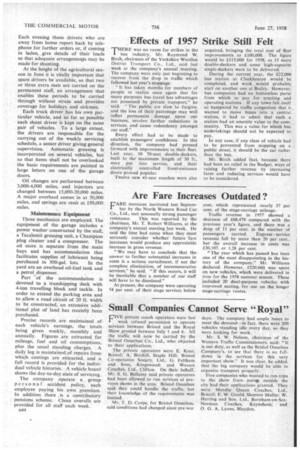West Lancashire Operators Offei
Page 86

Page 87

Page 88

If you've noticed an error in this article please click here to report it so we can fix it.
7ast Market Haulage
By
Ashley Taylor, A.M.I.R.T.E.
WHEN Mr. Harry Hague started up in business as a produce merchant in the fertile West Lancashire area some 25 years
ago, rather than be dependent upon outside transport facilities he borrowed a lorry from his brother. Before long, however, he found he needed his own vehicle and acquired a 30-cwt. MorrisCommercial. Matters progressed well so that in 1937 he decided on the acquisition of a business which carried with it an A licence, and he commenced the development of the transport side. A year later there were three vehicles, all Bedfords, in use.
Consolidated Progress During the war, slow but consolidated progress was made so that at the end a fleet of 10 was being employed. Two vehicles had B licences, three A licences and the remainder C licences. A limited company under the title of Harry Hague, Ltd., was formed in 1946 and, although the transport fleet came under nationalization, the company continued their business in the agricultural sphere.
Always in mind was the desire to return to road transport, and when the industry's fortunes changed tenders were quickly put in for suitable units. After a series of purchases had been made, a new company, under the title of Flague Transport, Ltd., was formed and came into operation on January 1, 1955.
The process of returning to independent road transport coin menced early in 1954. A number of vehicles was acquired and it became possible for operations to begin in earnest. Since that time the fleet has been largely renewed, fresh vehicles being acquired with greater suitability for particular traffics.
Newsprint forins a substantial item among the general haulage loads. So do commodities for the confectionery trade, raw materials in this case being moved in the one direction and the finished goods in the other. Substantial quantities of preserves in jars are carried, whilst potatoes, fruit and vegetables naturally loom large in the total.
A -speciality is made of handling perishable fruit, which has to be delivered to the markets quickly. A high proportion of the loads originates from the Merseyside docks or from growers in Lancashire, Cheshire, Yorkshire, and Lincolnshire, and is transported direct to markets throughout Great-Britain, the journeys in all cases being scheduled to provide deliveries at the individual markets by 6 a.m.
Between them, the two Hague companies organize the buying, transport and selling of agricultural produce. As an example of the methods used, the handling of new potatoes may be selected. Old potatoes are in being until the end of May, and then the new varieties come in gradually, one of the first areas providing new potatoes each year being Pembroke.
Since the end of the war, a seasonal office has been operated in that district so that the potatoes can be lifted in Pembrokeshire, collected by the lorries, and delivered to the various markets in the north-west for 6 a.m. the following morning. .
Little Outward Traffic
As the season progresses, and the later potato crops become available, the vehicles on these duties work gradually nearer home. As Pembroke is not a regular run, there is little in the way of regular outward loading. However, the amounts carried run up to 300 tons a week, or probably a total of something like 1,000 tons in the course of the season, which at Pembroke extends over about four weeks.
Fluctuations in the demand for agricultural produce mean a corresponding variiation in the mileages covered by the vehicles; for instance, a lorry that is running 1,500 miles a week in June may be down to 400 miles a week during the autumn.
Mr. Hague told me that after the war there was a great demand for fresh vegetables, but that the changing taste of the housewife had brought about a rise in the production of processed foods, with a consequent change in the constitution of the loads for carriers specializing in this field.
A large amount of traffic is moved between West Lancashire and the north-east coast, for this reason a depot having been opened in Newcastle upon Tyne. To deal with Scot
tish traffic, agency arrangements have been made in Glasgow. The company are now opening an office in Liverpool. General goods, including fruit from the docks, are carried to the northeast coast, where there is a re-delivery service for small consignments over the area lying between Morpeth and Teesside.
At the depot on the Mulberry trading estate, Felling on Tyne, there is covered accommodation for storage and transhipment. Regular nightly trunk services are run to Newcastle and to Glasgow, with occasional trunks to London and South Wales, plus seasonal work to Lincolnshire, Yorkshire, Cambridgeshire, Norfolk, Suffolk and Essex. Shunt drivers are provided at Newcastle and Glasgow to facilitate radial deliveries from those points.
The road transport company have been provided with 11 vehicles on A and special'A licences. The backbone of the fleet is formed by six' 16-ton Atkinson eight-wheelers and two 10ton Albion six-wheelers, there also being a four-wheeled Atkinson, a fourwheeled E.R.F. and a 10-ton Bedford articulated init with a York semitrailer, The agricultural department holds 14 vehicles on B and C licences.
These comprise two Leyland Comets, a 6-ton Bedford oil-erigined unit, four Bedford petrol vehicles, an 8-ton Bedford articulated unit, and a 6-ton Scammell Scarab and semitrailer, plus two 25-.cwt. vehicles of Austin and Thames manufacture and Austin, Morris and Thames vans.. With the exception of the vans all have ordinary platform bodywork with, attachments so that cabbage rails can be fitted for bulk transport a vegetables when necessary.
Records show that the trunk vehicles average up to 70,000 miles a year. Overall the fleet covers something like 14,000 miles a week. About half of the tyres fitted are Goodyears. Special care is taken in tyre maintenance, and examinations are frequently made by a Goodyear inspector.
Good results have been achieved by this policy, for covers run up to average mileages between 80,000 and 100,000, whilst cases of tyres running up to 115,000 miles are by no means unknown.
Detailed instructions are prepared at the Burscough Bridge head office for all drivers, full particulars of the loads and their distribution being given. Each evening those drivers who are away from home report back by telephone for further orders or, if coming in laden, give details of their loads so that adequate arrangements may be made for shunting.
At the height of the agricultural season in June it is vitally important that spare drivers be available, so that two or three extra men are carried on the permanent staff, an arrangement that enables these periods to be carried through without strain and provides coverage for holidays and sickness.
Each truck driver has his own particular vehicle, and so. far as possible each shunt driver is kept on the same pair of vehicles. To a large extent, the drivers are responsible for the carrying out of the weekly servicing schedule, a senior driver giving general supervision. Automatic greasing is incorporated on several vehicles, but so that items shall not be overlooked the basic requirements are painted in large letters on one of the garage doors.
Oil changes are performed between 3,000-4,000 miles, and injectors are changed between 15,000-20,000 miles. A major overhaul comes in at50,000 miles, and springs are reset at 150,000 miles.
Maintenance Equipment
Three mechanics are employed. The equipment of the garage includes a power washer constructed by the staff, a Tecalemit greasing unit, a Champion plug cleaner and a compressor. The oil store is separate from the main bays and has accommodation that facilitates supplies of lubricant being purchased in 500-gal. lots. In the yard are an overhead oil-fuel tank and a petrol _dispenser.
Part of the accommodation is devoted to a transhipping deck with 4-ton travelling block and tackle. In order to extend the parking area and to allow a road circuit of 20 ft. width to be constructed, an extensive additional plot of land has recently been purchased.
Precise records are maintained of each, vehicle's earnings, the totals• being given . weekly, . monthly and annually. Figures are extracted for mileage, fuel and oil consumptions, plus the usual standing charges. A daily log is maintained of repairs from which costings are extracted, and a full record is provided for the individual vehicle histories. A vehicle board shows the day-to-day state of servicing.
The company operate a , group personal accident policy, each employee paying his own premium. In addition there is a contributory pensions scheme. Clean overalls are provided for all staff each week. D44








































































































































